Istanbul has tried a number of solutions to tackle the traffic congestion that has resulted from its rapid urbanisation and population growth. This includes constructing motorways crossing the city from south to north, and bridges over the Bosphorus strait, the narrow waterway splitting the city and forming the continental boundary between Europe and Asia.
Today, it is developing a number of innovative subsea projects under the strait. One in particular is set to make a splash as a global contemporary architectural icon.
Going undersea
It was only recently that Istanbul — known as the City on the Seven Hills — embraced new tunnelling methods and began investing public funds in a programme to build “seven tunnels for seven hills.” The new technology also enabled Istanbul Metropolitan Municipality to explore going under, rather than over, the Bosphorus and a number of projects have followed.
The first project to go under the strait was the initial phase of the Marmaray rail tunnel, which opened in October 2013, while in February 2015 the city announced plans for a three-level tunnel for vehicles and the metro. Set for completion in 2020, some are calling it the Great Istanbul Tunnel.
In December 2016, Istanbul opened the Eurasia Tunnel, a double-deck subsea tunnel for vehicles. And not long after, excavation work began for the Üsküdar-Kabataş tunnel — a subsea tunnel for pedestrians and cyclists. When completed in 2019, it will be the first of its kind in the world.
Catering for all
The new two-storey Üsküdar-Kabataş tunnel will run for approximately 2km and connect Üsküdar and Kabataş, on the Asian and European side, respectively. It will connect mass transit centres (the entry/exit at Kabataş is by the pier and metro line, while the other side is near Üsküdar metro station and seaport) and will serve as an alternative to current ferry services.
The comfort of travellers is paramount. The tunnel, designed to promote walking, will be spacious and have large areas in the middle for exhibitions, interaction and leisure activities. On the upper deck, pedestrians will have the option of using travellators to cross the tunnel faster, or walking along at their own pace. Underneath, bicycle lanes will enable cyclists to speed through the tunnel, and a track for light electric vehicles will transport people who have trouble walking.
Tale of two methods
The team behind the concept, led by Project Director Serkan Mahmutoglu, Project Manager Özkan Hayta and Technical Lead Öztürk Özgür, has extensive experience in cutting-edge subsea tunnel schemes including the so-called “Unkapanı Underwater Motorway Bridge”, an immersed tube on piles traversing through the water column.
The team analysed how to construct the tunnel using two different methods: an Immersed Tube Tunnel (IMT) and a Tunnel Boring Machine (TBM). IMT involves dredging and then sinking into place a collection of segments that link together to form an underwater tunnel. A TBM excavates tunnels by boring through rock and soil.
The team identified a TBM as the preferred option because the single large diameter construction would be quicker, more cost-effective and have no major impact on marine traffic. It would also excavate much less mass than an IMT (making it friendlier to the environment) and would allow enough space on top for installing jet fans for ventilation.
An architectural wonder
Although primarily being constructed to meet the travel needs of Istanbulites, the interior of the new tunnel will echo the city’s architecture to enrich the experience of people travelling between Istanbul’s Asian and European parts.
The tunnel’s architect, Erik Behrens – who played a key role in delivering the design for the London 2012 Olympics – took inspiration from the city’s skyline and stunning churches and mosques to envisage a vibrant undersea chamber.
With intricately designed cladding panels and interspersed with artificial light wells in the ceiling, the ornate tunnel will give pedestrians and cyclists the impression of going on a journey through the city’s 8,000-year history. It is an ambitious, breathtaking concept — a modern architectural design that recently won the 2016 World Architecture News Future Projects Transport Award.
And to celebrate the historic location, it’s perhaps fitting that Behrens has designed a space for exhibitions and events at the tunnel’s midpoint, at the point where East meets West, at the heart of what are called — and what will be known for generations to come as — The Underwater Domes of Istanbul.
